AC Switch vs DC Switch: What's the Difference?
The first step on integrating a switch into the network is to get it powered up. And as to power supply, there are AC and DC power for network switch, both of which are used for increasing network uptime. Then what’s the difference between AC power Switch and DC power switch? Which type shall we used for our network? This post will give a detailed introduction for the difference between AC Switch and DC switch, and set out how to make a proper decision over AC Switch vs DC Switch.
AC Switch vs DC Switch: What Are They?
AC powered Ethernet switch often has a fixed AC power supply connector, thus it generally gets powered up through power cables such as IEC power cord, NEMA power cord, etc. PoE switches are typical AC switches. Take FS 24 port PoE switch as example, which is equipped with a single 100-240V AC power supply connector (as shown below). It is easy to power up AC switch. All you need to do is connect it to the power socket with proper power cable. For some advanced network switch, turning on its power switch is also necessary.

DC powered Ethernet switch can be configured with an internal or external DC power supply. And the external DC power supply is more popular nowadays, which is also known as redundant power supply. Modern fiber switch often has more than one redundant power supply (e.g the following FS 10GbE switch is equipped with two DC power supply). Except for powering up switch, the DC redundant power supply can also protect other power supply when it fails with shorted outputs.

AC Switch vs DC Switch: What's the Difference?
In the market, there are Ethernet switches that support only AC power supply or DC power supply, and there are also some switches which can be used with both AC and DC power supplies. However, the switch can only support one type of power supply at the same time. That’s to say, if you use DC power supply to power up your switch initially, the switch will detect it and operate with DC power. In this case, AC power supply installed in the switch will be disabled. Even if you try to install AC power supply when the switch is operating with DC power, it will also disable the AC power and generates an alarm. So remember not to mix AC and DC power supplies in a switch.
Conclusion
AC and DC power supplied Ethernet switches are all commonly used nowadays. You can select one or the other according to your own case and needs. FS provides both AC and DC switches. For example, we have AC switches such as 8/24/48 port PoE+ Managed Switches which support up to 600W. High quality DC switches are also available. Customers can also custom the power type of switches.
Originally published at http://www.fiber-optic-transceiver-module.com/ac-switch-vs-dc-switch-whats-the-difference.html
Decodierung von 100G QSFP28 Transceiver und QSFP28 Breakout Kabel
Heute ist der Trend für 100G bullisch und unvermeidlich. Um ein 100G-Netzwerk zu erreichen, können Sie 100G-Transceiver wie CXP, CFP, CFP2, CPAK, CFP4, QSFP28 und QSFP28 Breakout-Kabel verwenden. Unter diesen optischen Modulen, die 100G-Verkehr verbinden können, ist der QSFP28-Transceiver das am meisten bevorzugte Modul mit der kleinsten Größe und dem niedrigsten Stromverbrauch.
100G QSFP28 Schnittstelle: MTP/MPO und LC Schnittstelle
100G QSFP28 Transceiver sind in Typen wie 100GBASE-SR4, 100GBASE-PSM4, 100GBASE-CWDM4 und 100GBASE-LR4 erhältlich, die verschiedene Schnittstellen haben. Für den Transceiver 100GBASE-SR4 QSFP28 und 100GBASE-PSM4 QSFP28 sind sie mit MTP/MPO-Schnittstelle ausgestattet. Diese Art von QSFP28-Modul bietet 4 unabhängige Vollduplex-Sende- und Empfangskanäle, und jeder kann bis zu 28 Gpbs Datenrate pro Kanal verarbeiten. Ausgestattet mit einer 100G QSFP28 MPO-Schnittstelle sollten diese Transceiver mit einem 12-Faser-MTP/MPO-Patchkabel verbunden werden.

Für 100GBASE-CWDM4 QSFP28 und 100GBASE-LR4 QSFP28 sind sie mit einer Duplex-LC-Schnittstelle konfiguriert. Das 100GBASE-CWDM4 QSFP28-Modul integriert Sende- und Empfangspfad in einem Modul mit 4 Spuren optischer Signale (25,78125 Gbps pro Spur), die auf der Sendeseite in einen LC-Stecker gemultiplext werden. Und 100GBASE-LR4 QSFP28 ist ein vollständig 4x25 Gbps Transceiver-Modul, das auch durch Multiplexen und Demultiplexen optischer Signale arbeitet. Sie sind alle Duplex-Module und müssen über Single-Mode-Glasfaserkabel mit Duplex-LC-Stecker betrieben werden.

Maximale unterstützte Entfernung für 100G QSFP28 Transceiver: bis zu 80 km
Der Transceiver 100G QSFP28 kann sowohl für Kurz- als auch für Fernübertragung verwendet werden. Bei langen Übertragungsstrecken werden oft 100G QSFP28 LR4 Transceiver verwendet. Sie sind für die Verwendung in 100-Gigabit-Ethernet-Verbindungen auf bis zu 10 km Singlemode-Glasfaser konzipiert und entsprechen den Standards QSFP28 MSA, IEEE 802.3ba 100GBASE-LR4 und IEEE 802.3bm CAUI-4. Die folgende Tabelle zeigt die maximale Verbindungslänge, die von anderen 100G QSFP28-Transceivern unterstützt wird.

Die Übertragungsdistanz der oben erwähnten optischen 100G-Transceivermodule ist auf 10 km beschränkt. Was ist, wenn Kunden ein Ultra-Langstrecken-Netzwerk über 10 km bauen müssen? Kann 100G QSFP28 eine so große Entfernung bewältigen? Jetzt mit dem Aufkommen von 100G QSFP28 ER4, kann dies erreicht werden! Vor nicht allzu langer Zeit war QSFP28 ER4 noch ein Versprechen und existierte nicht. Aber jetzt können einige Anbieter wie FS.COM es bereits bereitstellen. Es kann eine Entfernung von bis zu 40 km unterstützen. Außerdem soll in diesem Jahr auch der 100G QSFP28 ZR4 Transceiver verfügbar sein, der eine Linklänge von bis zu 80km bewältigen kann.
100G QSFP28 Breakout-Kabellösung
Für Kunden, die von 25G auf 100G aufrüsten möchten, bietet das 100G QSFP28-Modul auch eine flexible Möglichkeit zur Erweiterung Ihres Netzwerks. Der Transceiver 100GBASE-SR4 QSFP28 kann mit 4 Transceivern 25GBASE-SR SFP28 auf die gleiche Weise wie der Transceiver 40GBASE-SR QSFP + mit 4 Transceivern 10GBASE-SR SFP + verbunden werden. Um diese Verbindung zu erreichen, benötigen wir lediglich ein 12F MPO-LC Patchkabel.
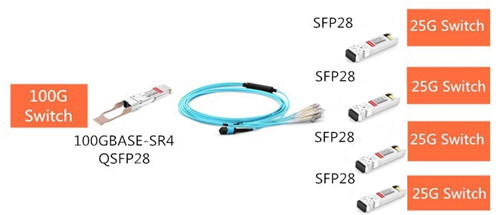
Abgesehen davon, dass dieses MPO-12 zu LC verwendet wird, kann das QSFP28-Breakout-Kabel auch für 100-G-Breakout-Verkabelungsanwendungen verwendet werden. Dieses QSFP28-Breakout-Kabel verbindet Datensignale von jedem der 4 Kupferpaare am QSFP28-Ende mit dem einzelnen Paar jedes der SFP28-Enden und ermöglicht so eine höhere Port-Bandbreite, Dichte und Konfiguration bei geringen Kosten und reduziertem Strombedarf in den Rechenzentren.
QSFP+ vs QSFP28: Kann 100G QSFP28 für 40G verwendet werden?
Wie ihr Name andeutet, unterscheidet sich QSFP+ und QSFP28 in "28". QSFP28 ist ein Hot-Plug-fähiges Transceiver-Modul, das für eine Datenrate von 100G ausgelegt ist. QSFP28 integriert 4 Sende- und 4 Empfängerkanäle. "28" bedeutet, dass jede Spur bis zu 28G Datenrate überträgt. Während QSFP+ unterstützt die Datenrate von 40G, 4 Kanäle für die Übertragung und 4 Kanäle für den Empfang, jede Spur mit 10G. Im Allgemeinen kann der 100G QSFP28 Transceiver nicht am 40G QSFP Port verwendet werden. Es ist jedoch ein weiterer Fall, einen QSFP28-Transceiver in einen 40G QSFP+-Port einzubauen, wenn Switches dies unterstützen. In dieser Situation kann ein QSFP28 wie ein QSFP+-Transceiver-Modul in 4x10G ausbrechen und somit für 40G verwendet werden. Außerdem entspricht der QSFP28-Anschluss dem QSFP+-Anschluss (beide sind der MPO12-Kabelanschluss) und die QSFP28-Pinbelegung ist identisch mit der QSFP+-Pinbelegung. Bei den meisten Switches kann 40G QSFP+ am 100G QSFP28-Port verwendet werden.
VLAN vs Subnet: What Are Their Differences?
VLAN and Subnet are both developed to deal with segmenting or partitioning a portion of the network. And they also share such similarities as restricting broadcast domains or ensuring security through isolation of different sub-networks. However, there are obvious differences between them on operation, functionality and deeper objectives. This post will focus on VLAN vs Subnet: what's the difference?
VLAN vs Subnet: What Are They?
Subnet is a small network composed by a group of IP addresses. It is part of a larger network. Any IP address within the same Subnet can communicate with each other without using routing devices. To be clear, we can think Subnet as the department of a company, people in the same department can talk freely without going out of their department. If you want to reach a address outside of your Subnet, you will have to go through a router or modern Gigabit Ethernet switch with router functionality. Since Subnet is related to IP address, it often works at layer 3.
VLAN, also known as virtual LAN, is a group of devices on one or more LANs in regardless of physical location. That’s to say, it allows devices to be grouped together even though they are not connected on the same fiber switch. However, it often requires the network hardware/software to support VLAN functionality, for example, VLAN switch is essential for setting up a VLAN network. In VLAN, configuration of the network can be done via software extensively. Basically, VLANs are used at layer 2 to break up broadcast domains.
VLAN vs Subnet: What’s the Difference?
As mentioned above, VLAN and Subnet are totally different things in a close look. The following chart lists the differences between VLAN and Subnet in details:
|
Parameter
|
VLAN
|
Subnet
|
|
Definition
|
VLAN is a logical LAN that contains broadcasts within itself, and only hosts belonged to that VLAN will see those broadcasts.
|
Subnet is an IP address range of IP addresses that help hosts communicate over layer 3.
|
|
Logical and Physical Network
|
VLAN allows us to create different logical and physical networks.
|
Subnet allows us to create logical networks through the same physical network.
|
|
Network Member Control
|
A VLAN is configured at server/router side. The one who controls the router/server decides which computer/port is assigned to which VLAN. For example, if you have a 24 port 10GbE switch, you can assign 12 ports to VLAN 1 and the others to VLAN 2.
|
A Subnet is determined by the IP you use and the IP can be chosen by the admin of a computer (or device). Therefore it is done on client side - you can not control it.
|
|
OSI Layer
|
VLAN is a layer 2 term where MAC addresses work.
|
Subnet is a layer 3 term where IP layer works.
|
|
Hardware/Software Based
|
More of software-based terminology.
|
More of hardware-based terminology.
|
|
Security & Control
|
VLANs perceived to be more secure and provide more robust control for the network.
|
Subnet has limited control in comparison to VLAN.
|
|
Major Benefit
|
VLAN is extremely flexible, it brings better work performance, less traffic, and more efficiency.
|
A Subnet will not be affected when other Subnets going down or having technical breakdowns.
|
VLAN vs Subnet: Which One Do You Like?
VLAN and Subnet both have their advantages and limits. For example, VLAN allows for creation of different logical and physical networks while Subnet only allows for creation of different logical networks. However, if a network sniffer is employed, users from one Subnet can discover the existence of other Subnets, this will not happen to users of different VLANs. So VLAN vs Subnet: which do you prefer?
Originally Published at http://www.fiber-optic-transceiver-module.com/vlan-vs-subnet.html
Why You Need a Managed 8 Port PoE Switch
Gigabit PoE switch, or power over Ethernet switch, has seen massive adoption these days by providing improved network flexibility and performance. A Gigabit PoE switch transmits both data and power supply simultaneously to network devices such as VoIP phones, Wireless AP and network cameras without changing existing Ethernet cabling structure, which in turn, greatly reduce the cabling complexity as well as the cost of installation and maintenance. These exists 8/10/16/24/48 port PoE switches with gigabit speed and essential managing functions, among which a 8 port Gigabit PoE switch is poised as a cost-effective choice for home and business use. Let’s see what we can achieve with a 8 port PoE switch.
8 Port PoE Switch: Managed or Unmanaged?
Like choosing a standard data switch, we’ll inevitably find ourselves in a dilemma: should we choose a managed or unmanaged Gigabit PoE switch? The answer is pretty easy and straightforward – a managed PoE switch is always better. Managed switches typically offers advanced security features and allows for administrators visibility and control. Besides, a managed PoE switch also offers higher level of manageability and control, so you’re able to program each port individually while keep the network operating at peak efficiency. This results significant saving on power and cost. Additionally, a managed Gigabit PoE switch is capable of configuring, managing and monitoring the LAN – setting/disabling the link speed, limiting bandwidth or grouping devices into VLANs.
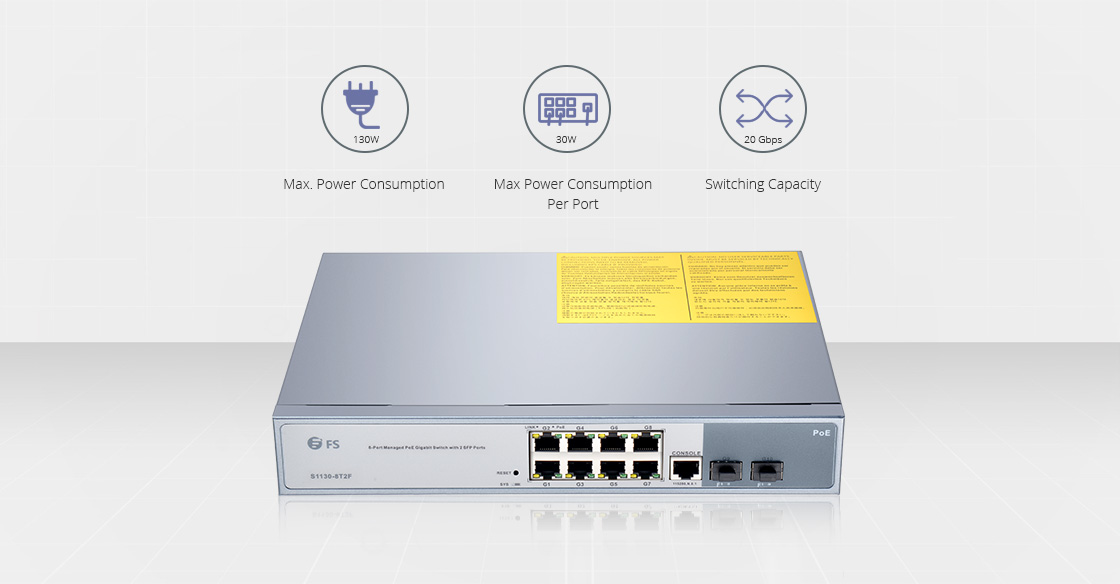
How to Use a Managed 8 Port PoE Switch?
Managed Gigabit PoE switch has become a preferable option for enterprise networks, with dramatically decreased price, expanded feature sets and improved ease of use. Experience from those who have dealt with a managed 8 port PoE switch also demonstrates that this is a journey well worth taking. You can use a managed 8 port PoE switch to creates VLANs and limit access to specific devices, to use Layer 3 routing capability and to remotely monitor network performance.
Common applications of a managed 8 port PoE switch includes the following aspects.
To connect this PoE enabled device, you need to know the power consumption of these device, as well as a total power/ power per port of your PoE switch. For example, you have a managed 8 port PoE switch with a power budget of 250W with the maximum power consumption per port 30W. Assume to power an IP Camera network, you’ll need a total power per port of 30W. Then you can connect all the 8 ports with IP cameras with a total power consumption of 240W (within the budget of 250W).
| Voice over IP phones | Enterprise can install PoE VoIP phone, and other Ethernet/non-Ethernet end-devices to the central where UPS is installed for un-interrupt power system and power control system. |
| Wireless Access Points | Museum, sightseeing, airport, hotel, campus, factory, warehouse can intall the WAP anywhere. |
| IP Camera | Enterprise, museum, campus, hospital, bank can install IP camera without limits of install location – no need electrician to install AC sockets. |
The key applications are illustrated as following.
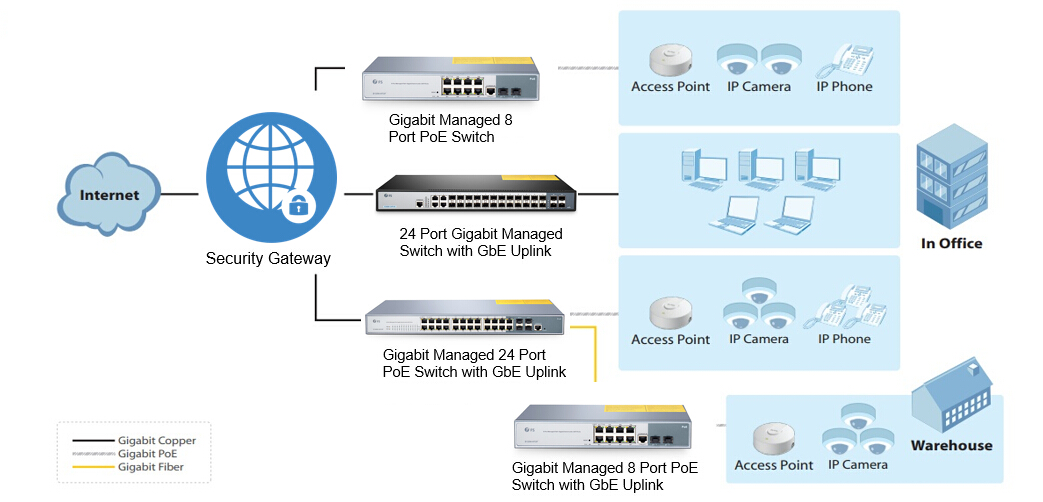
One of the frequently asked question is that whether we can mix PoE and Non-PoE devices on the same PoE network. The answer is positive. PoE will only send power if it requested by the device. Otherwise the switch just interacts with it as if it were a regular switch. When connecting a managed 8 port PoE switch to non PoE compatible devices, a PoE splitter is commonly adopted – it delivers data and DC power through separate connections.
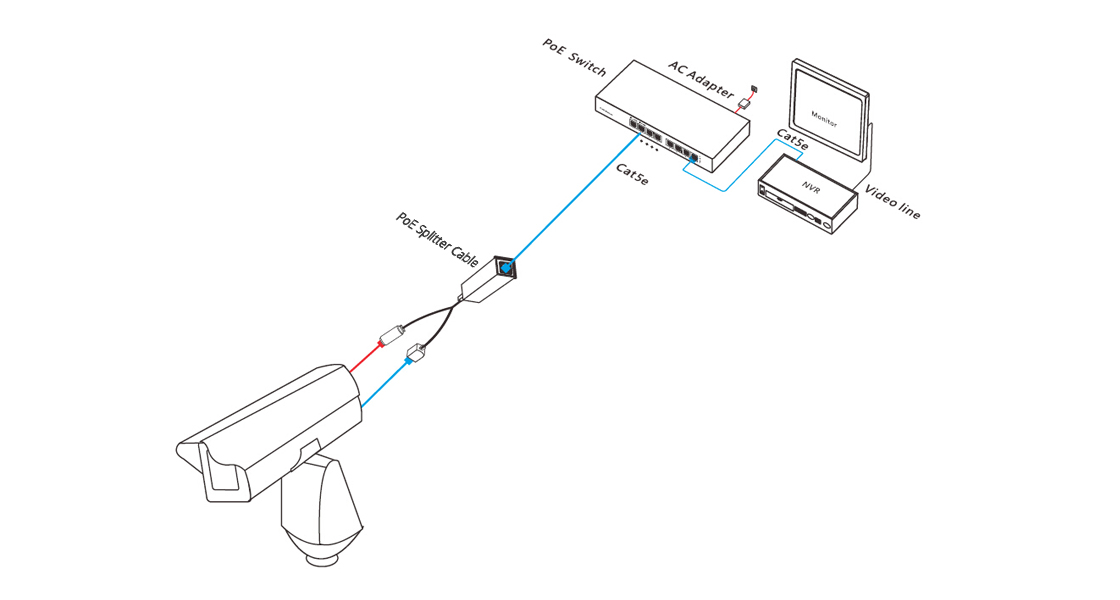
FS.COM 8 Port PoE Switch Solution
Managed gigabit PoE switch has become a better choice if you ever anticipate advanced network features to meet business growth. A managed 8 port PoE switch is the best fit for SMB network and home use with relatively small traffic flow. FS.COM fully understands customer expectations and offers managed 8 port PoE switch with the price starting from $159. Besides, we also provide 24 port PoE switch and 48 port PoE switch to help future-proof your network and unleash the potential of your business. Feel free to contact us via sales@fs.com for more solutions.
Network Switch Port Mirroring vs. Network TAP
Nowadays networks are carrying significant volumes of data at increasing speeds - it is getting more complex than ever. Consequently, network visibility is critical to monitor, manage and protect your network. So having access to inner working condition of the network is paramount to every network manager. Network TAP and network switch port mirroring provide direct access to the actual packets navigating across networks. If both options work, which is a better choice? And when should we choose one over the other? We try to address those issues here.
Basics of Network Switch Port Mirroring
Network switch port mirroring is nothing new for us. It is performed by a mirror port - a software feature built into a network switch that creates a copy of selected packets passing through the device and sends them to a designated mirror port. It enables a network manager to configure or change the data to be monitored. Since the primary purpose of a network switch is to forward production packets, port mirroring data is often with a lower priority. Besides, switch port mirroring uses a single egress port to aggregate multiple links, so it is easily oversubscribed.
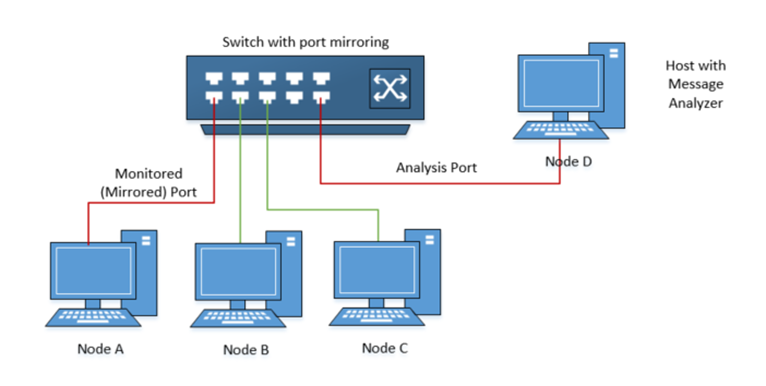
- Low cost, using existing switch capabilities.
- Remotely configurable through the network.
- Captures intraswitch traffic.
- Drops packets on heavily used full-duplex links.
- Filters out Physical Layer errors.
- May burden the switch’s CPU to copy data.
- May change frame timing, altering response times and slowing network performance.
Network TAP Explanation
A network TAP (Test Access Point) is a passive device that used to directly connect to the cabling infrastructure. Instead of two switches or routers connecting directly to each other, the network TAP is put between the two devices and all data flows through the TAP. With an internal splitter, the TAP creates a copy of the data for monitoring while the original data continues unimpeded through the network. In this case, packet of any size can be copied by TAP – it thus eliminates any chance of oversubscription. Once the data is TAPed, the duplicate copy can be used for any sort of monitoring, security, or analytical use.
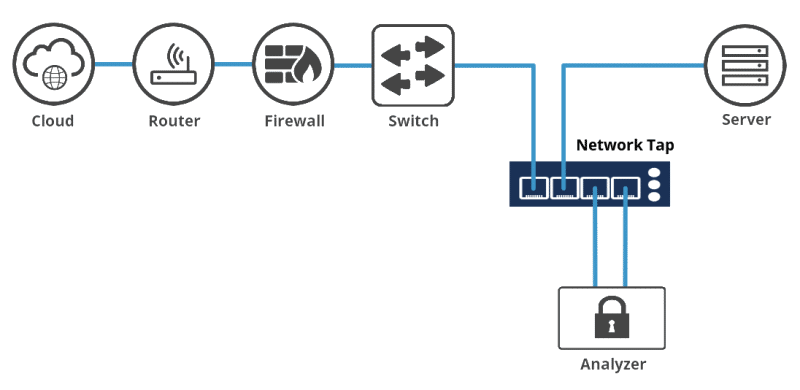
- Captures send and receive data streams simultaneously, eliminating the risk of dropped packets.
- Provides full visibility into full-duplex networks.
- Captures everything on the wire—including Physical Layer errors—even when the network is saturated.
- Requires the purchase and installation of additional hardware.
- Analysis device may need dual-receive capture interface.
- Only captures data between network devices; can’t monitor intra-switch traffic.
Network Switch Port Mirroring vs. Network TAP: Differences?
The differences concerning port mirroring and network TAP is summarized as following.
- TAPs create an exact copy of the bi-directional network traffic at full line rate, providing full fidelity for network monitoring, analytics and security. While network switch mirror ports are easily oversubscribed – resulting in dropped packets, which leads to inconsistent results for monitoring and security purposes.
- Passive TAPs provide continuous access to traffic and require no user intervention or configuration once installed. Network switch port mirroring, however, can have a negative performance impact on the switch itself, sometimes affecting network traffic.
- Network TAPs allow for traffic monitoring for a particular segment. But port monitoring traffic output can change from day to day or hour to hour – resulting in inconsistent reporting. When configured mirror ports incorrectly, it will impact network performance.
- TAPs are usually protocol transparent – be it carried in the traffic or if it is IPv4 or IPv6. All traffic is passed through a passive TAP.
- Network switch mirror ports are limited in number compared to the number of ports that may require monitoring, and consume ports that could otherwise be carrying production traffic.
Port Mirroring vs. Network TAP: When to Use Which?
Simply put it, TAPs are a key component and should be applied in any system demanding 100% visibility and traffic fidelity. And whenever traffic volumes are moderate to high, it’s better to deploy network TAPs. Note that inserting a TAP into an existing network link requires a brief cable disconnect, so TAPs are typically installed during a maintenance window, or to install it during the early design phase.
On the other hand, network switch port mirroring works best for ad hoc monitoring of low volumes of data in locations where TAPs have not been installed. It still represent the only means for accessing certain types of data, such as data crossing port-to-port on the same switch, remote locations with modest traffic that cannot justify a fulltime TAP, or traffic that stays within a switch that never reaches a physical link.
Conclusion
There is no doubt that both TAPs and network switch mirror ports can provide valid access to data if used correctly. Choose TAPs when you can justify the cost, while opt for port mirroring where you must. FS.COM is backed by a professional and experienced team to provide solutions for network TAPs and Ethernet switch, for more details, feel free to contact us via sales@fs.com.
QSFP + zu SFP + Adapter (QSA Adapter) vs. QSFP + zu SFP + Breakout-Kabel
Leute fragen häufig nach machbaren Lösungen zwischen 10G und 40G Servern. QSFP + Breakout-Kabel wie QSFP + zu 4 SFP + -Kabeln und MTP zu 4 LC-Kabelbaumkabel sind die gebräuchlichsten Geräte für die Verbindung zwischen QSFP + -Ports und SFP + -Ports. Vor kurzem hat Cisco jedoch eine neue Art von Produkt auf den Markt gebracht: das Modul QSFP + zu SFP + Adapter (QSA Adapter), das eine reibungslose Migration auf 40 Gigabit Ethernet ermöglicht. Ist es eine bessere Lösung für die Migration von 10G nach 40G? Sollte ich den QSA-Adapter oder das 40G QSFP + Breakout-Kabel verwenden? Dieser Artikel beantwortet die obigen Fragen und gibt Ihnen einige Vorschläge.
QSA Adapter - Ist es eine bessere Lösung für 40G Migration?
Der QSFP + zu SFP + Adapter (QSA Adapter), spezifiziert von Cisco, ist das Modul im QSFP + Formfaktor mit einer Buchse für SFP + Kabelstecker auf der Rückseite (siehe unten). Wenn Sie den QSFP-Port mit einem SFP + -Port verbinden, fungiert der QSA-Adapter normalerweise als Schnittstelle für SFP + / SFP-Kabel. Das bedeutet, dass Sie eine SFP + / SFP-Optik, die an einem 10-Gbit / s-Port dieses Moduls arbeitet, effektiv einstecken und das Modul in einen QSFP-Port-Käfig einsetzen können, um den 40G-Ethernet-Übergang zu realisieren. Der QSA-Adapter gewährleistet die problemlose Verbindung zwischen 40-Gigabit-Ethernet-Adapter und 10-Gigabit-Hardware mit SFP + -basierter Verkabelung. Sobald der QSA-Adapter im Jahr 2016 herauskam, wurde er bald als die effektive Lösung für die Umwandlung von 40G-Ports in die 10G-Ports angesehen.
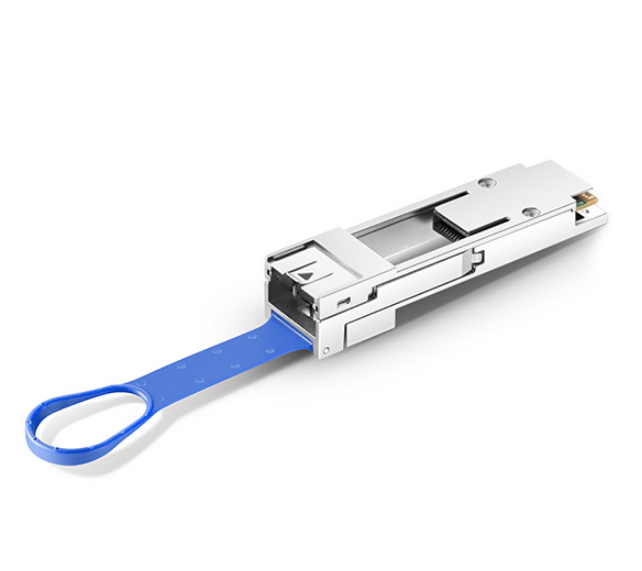
Übersicht über die 40G QSFP + Breakout-Kabel
Benutzer verwenden normalerweise entweder die Breakout-Kabel QSFP + bis 4 SFP + oder MTP-zu-LC-Kabel, um den Downlink-40G-Anschluss des ToR (Top of Rack) -Zugriffsschicht-Switches in den 4x10G-Fan-Out-Modus zu konvertieren und dann an den 10G-Gehäuse-Serverport anzuschließen. QSFP + zu SFP + Breakout-Kabel, einschließlich des Direct-Attach-Kupferkabels (DAC) und des aktiven optischen Kabels (AOC) besteht aus einem QSFP + -Anschluss an einem Ende und vier SFP + -Anschlüssen am anderen Ende. Die Kabel verwenden leistungsstarke integrierte serielle Duplex-Datenverbindungen für die bidirektionale Kommunikation auf vier Verbindungen gleichzeitig.
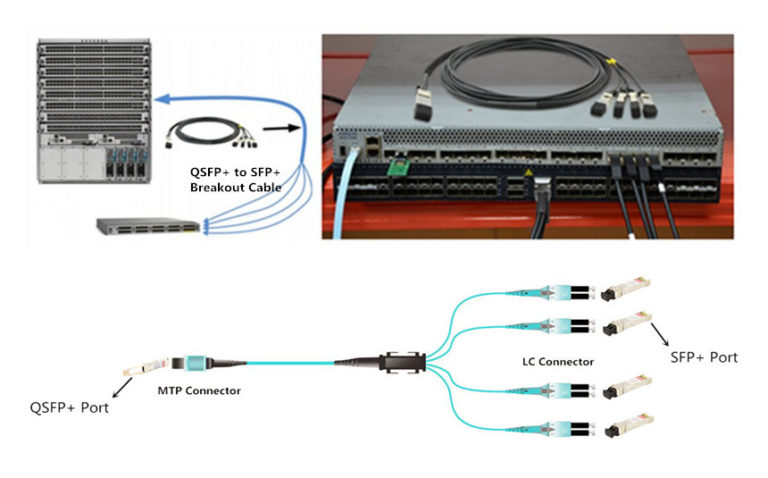
Während das MTP-zu-LC-Kabelbaumkabel ein MTP-Kabel an dem einen Ende und vier LC-Anschlüsse an dem anderen Ende aufweist. Diese Art von Kabel wird empfohlen, um im selben Rack innerhalb der kurzen Entfernung verwendet zu werden. Das Bild oben zeigt die direkte Verbindung zwischen den QSFP + Transceivern und den SFP + Transceivern unter Verwendung des MTP zu LC Kabelbaumkabels.
QSA-Adapter oder QSFP + Breakout-Kabel?
In diesem Teil werde ich einen Vergleich zwischen QSFP + zu SFP + Adapter-Modulen (QSA Adapter) und QSFP + Breakout-Kabeln hinsichtlich Kosten, Leistung und Kompatibilität anstellen.
Das QSA-Adaptermodul ist nicht durch Multi-Source-Agreement (MSA) zertifiziert, sondern ein einziges Quellparadigma, das von wenigen Anbietern definiert wird. Der einzige Anbieter besitzt sein Patent, daher sind die QSA-Adapter auf dem Markt ziemlich teuer. Nichtsdestotrotz unterstützen QSFP + Breakout-Kabel, die vom MSA-Standard abgedeckt werden, Kupfer- und optische Verbindungen, die viel billiger sind als QSA-Adapter. Der Kostenvergleich zwischen QSA-Adapter und QSFP + Breakout-Kabel (DAC, 1m) ist in der folgenden Tabelle aufgeführt.
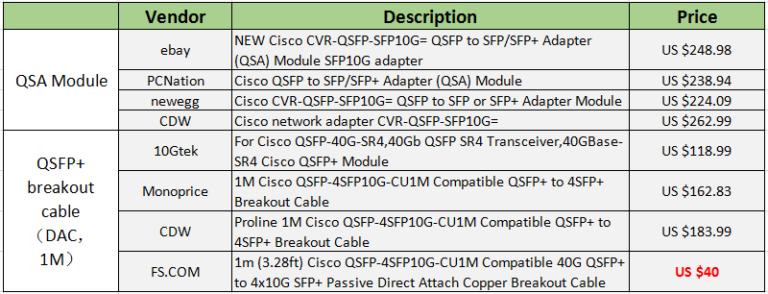
Mit dem QSA-Adapter können Benutzer SFP + / SFP-Optiken verwenden, um mit einer einzigen 10G-Verbindung eine Verbindung zur 40-Gbit / s-Datenrate herzustellen. Allerdings gibt es den QSA-Adapter nur in 10G-40G-Geschwindigkeit, was auch die Gründe für die Unbeliebtheit des Marktes erklärt. QSFP + bis 4 SFP + Breakout-Kabel teilen den 40G-Kanal in einen 4x10G-Kanal auf, der viermal mehr Daten überträgt als der QSA-Adapter.
QSA-Adapter sind laut Cisco in einer 40-Gigabit-Ethernet-Kompatibilitätsmatrix verfügbar. Cisco SFP / SFP + -Transceiver, die an die QSA-Adapter angeschlossen werden können, werden als Cisco 10GBASE-SR-, LR-, ER-, ZR-, DWDM SFP + -, FET-10G- und 10G SFP + -Kabel sowie als SFP (1000BASE-T, SX, LX, EX, ZX). Wie für die Breakout-Kabel QSFP + zu SFP + haben verschiedene Hersteller unterschiedliche kompatible Probleme. Denken Sie daran, dass Sie die zuverlässigen Glasfaser-Transceiver-Hersteller finden sollten.
- Bevor Sie die QSA-Adapter oder die QSFP + Breakout-Kabel verwenden, um einen 40-Gigabit-Ethernet-Port mit einem 10-Gigabit-SFP + -Port zu verbinden, müssen Sie den Fan-Out-Modus Ihrer Geräte aktivieren.
- Nicht alle 40G-Karten und -Switches können in den 4x 10Gb-Modus aufgeteilt werden, z. B. unterstützen die Mellanox QSFP-Karten nicht den Breakout QSFP bis SFP +, aber ihre Switches können.
- Mit den QSA-Adaptern können Sie die SFP + -Module direkt in einem QSFP + -Port verwenden, aber Sie können die QSFP + -Optikkabel nicht in einem QSA-Setup verwenden.
Die Telecom-Industrie wurde schnell modifiziert. Daher ist es kostengünstiger, zusätzliche Investitionen in Hochgeschwindigkeits-Switches anstelle von Breakout-Kabeln und teuren QSA-Adaptern zu tätigen.
Fazit
Sowohl die QSFP + Breakout-Kabel als auch die QSA-Adapter ermöglichen eine reibungslose Migration auf das 40 Gigabit Ethernet. Mit diesen Optiken können Sie vorhandene 10G SFP + -Kabel, optische Transceiver und Switches beim Upgrade auf 40G-Ethernet wiederverwenden. QSFP+ Breakout-Kabel gelten als die kosteneffektivsten und zuverlässigsten Lösungen für die meisten Situationen, aber QSA-Adapter sind für die Anwendung mit einer einzigen 10G-Verbindung vorzuziehen.
LWL-Kabel: Multimode Fiber Oder Single Mode Fiber
Vor kurzem, LWL-Kabel wird immer beliebter in der Telekommunikation wegen seiner großen Bandbreite, schnelle Geschwindigkeit, Fernübertragung und niedrige Kosten. Single Mode Fiber und Multimode-LWL-Kabel sind in vielen Netzwerken wichtig, um optische Signale zu übertragen. Obwohl Sie das gleiche Funktionsprinzip und Funktionen haben, hat jeder von Ihnen Ihre eigenen vor-und Nachteile.
Single Mode Fiber und Multimode Fiber Übersicht
Personen, die mit optischen Netzwerken arbeiten, können mit Glasfaserkabeln vertraut sein. Und Sie können wissen, die grundlegende Struktur und Unterschiede zwischen Multimode Fiber und Single Mode Fiber. Hier ist eine einfache Tabelle mit den grundlegenden Kenntnissen von Ihnen.

Von der Tabelle, die wir sehen können, hat Multimode-Fiber einen größeren Kerndurchmesser. Und es hat mehrere Übertragungsarten, aber Sie sind nur für Kurzstreckenverbindungen geeignet. Während Single-Mode-LWL-Kabel hat einen kleinen Kerndurchmesser, durch die nur ein Modus wird in der Regel 1310 oder 1550nm zu verbreiten. Aus diesem Grund sind diese Kabel oft in der Fernübertragung durch seine weniger Dispersion eingesetzt. Das folgende ist ein direkt-Anzeigebild zeigt die Durchmesser Unterschiede zwischen Single-Mode-LWL-Kabel-und Multimode-Glasfaserkabel.
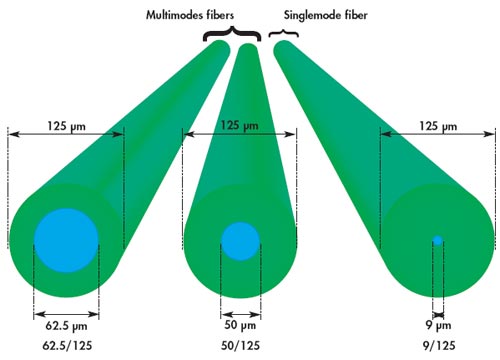
Vor-und Nachteile von Single Mode Fiber
Wie oben erwähnt, ist Single-Mode-LWL-Kabel besser geeignet für lange Läufe Anwendungen im Vergleich mit Multimode-Glasfaserkabel. Mit Ausnahme dieser, Single-Mode-LWL-Kabel hat auch andere drei Vorteile.
- erhöhen Sie die Bandbreitenkapazität.
- begrenzte Datenstreuung und externe Interferenzen. Der Single-Input-Modus ermöglicht SMF die Lichtstreuung zu begrenzen, die wiederum reduzieren Lichtabfall und erhöhen Datenübertragungs Daten.
- schnelle Übertragungsgeschwindigkeit. Single-Mode-LWL-Kabel kann die Datenübertragung Geschwindigkeit bis zu 10 Gbps.
Jede Münze hat zwei Seiten. Single-Mode-Glasfaserkabel hat auch Nachteile. Die eine ist die Kosten. Obwohl es eine bessere Leistung in Long-Runs-Übertragung als Multimode-LWL-Kabel, Single-Mode-Glasfaserkabel oft mehr Kosten.
Vor-und Nachteile des Multimode-LWL-Kabel
Mit einem größeren Faser-Kern und gute Ausrichtung Toleranzen, Multimode-Faser-Kabel und Komponenten sind weniger teuer und sind leichter zu arbeiten mit anderen optischen Komponenten wie Glasfaser-Anschluss und Fiber-Adapter, im Vergleich mit Single-Mode-Glasfaserkabel. Darüber hinaus bietet Multimode-LWL-Kabel auch hohe Geschwindigkeit und hohe Bandbreite über kurze Strecken. Und Sie können mehrere optische Signale gleichzeitig übertragen.
Allerdings, Multimode-Fiber hat eine hohe Streuung und Dämpfungs Geschwindigkeit, die Qualität der optischen Signale wird reduziert, da die Übertragungsstrecke wird immer länger. Daher wird Multimode-LWL-Kabel häufig in Daten-und Audio/Video-Anwendungen in LANs verwendet.
Welche zu wählen, Single Mode Fiber-oder Multimode Fiber?
Besitzen, um Ihre eigenen Eigenschaften, Single-Mode-Glasfaserkabel und Multimode-Faser-Kabel haben verschiedene Anwendungsbereiche. Auf der Grundlage des Übertragungs-und Bereitstellungs Budgets ist das Multimode-LWL-Kabel, wenn der Übertragungsabstand weniger als 2km beträgt, besser, da es weniger teure optische Transceiver und andere Komponenten benötigt. Und wenn der Abstand über 2km ist, wird Single-Modus-Faser sein.